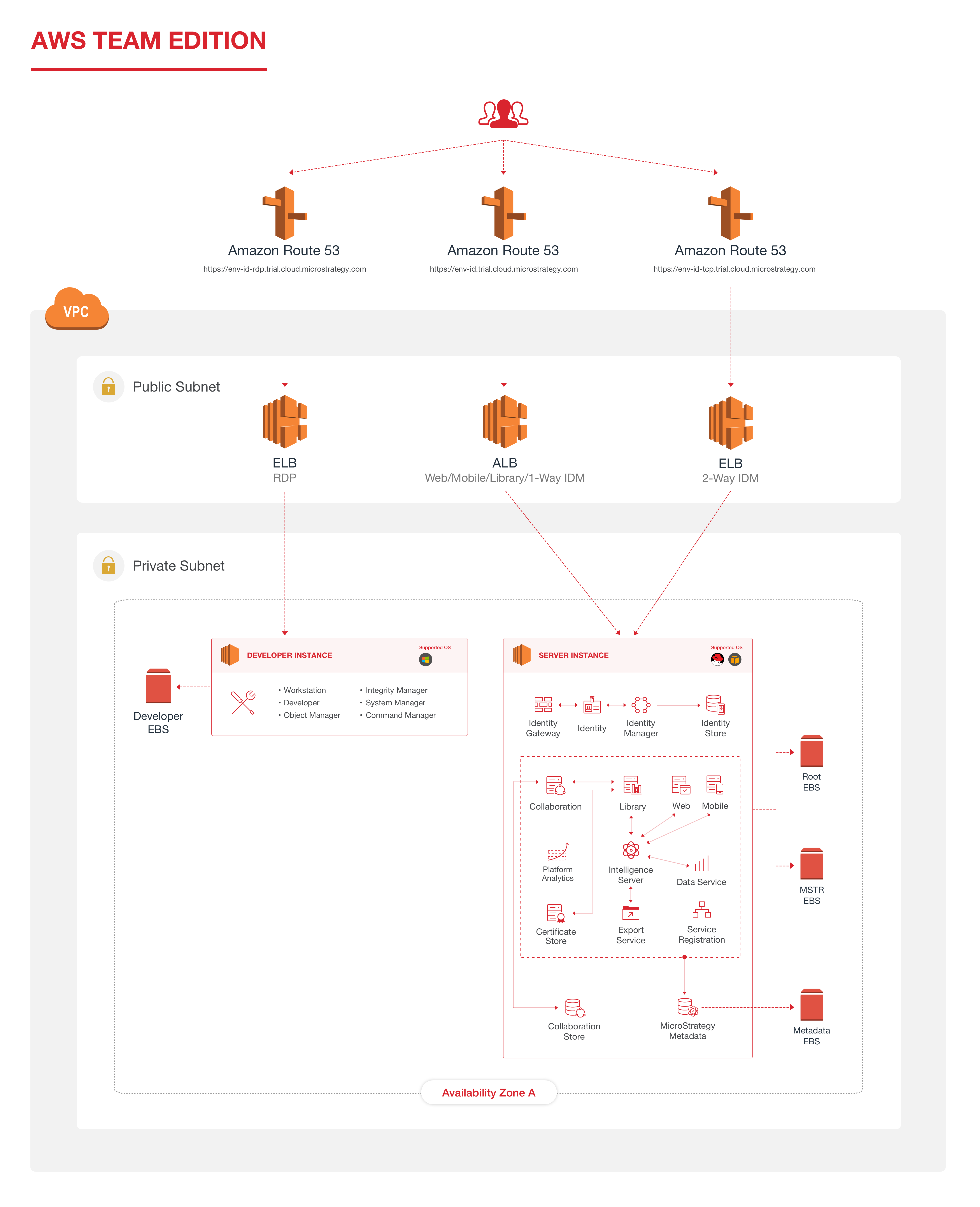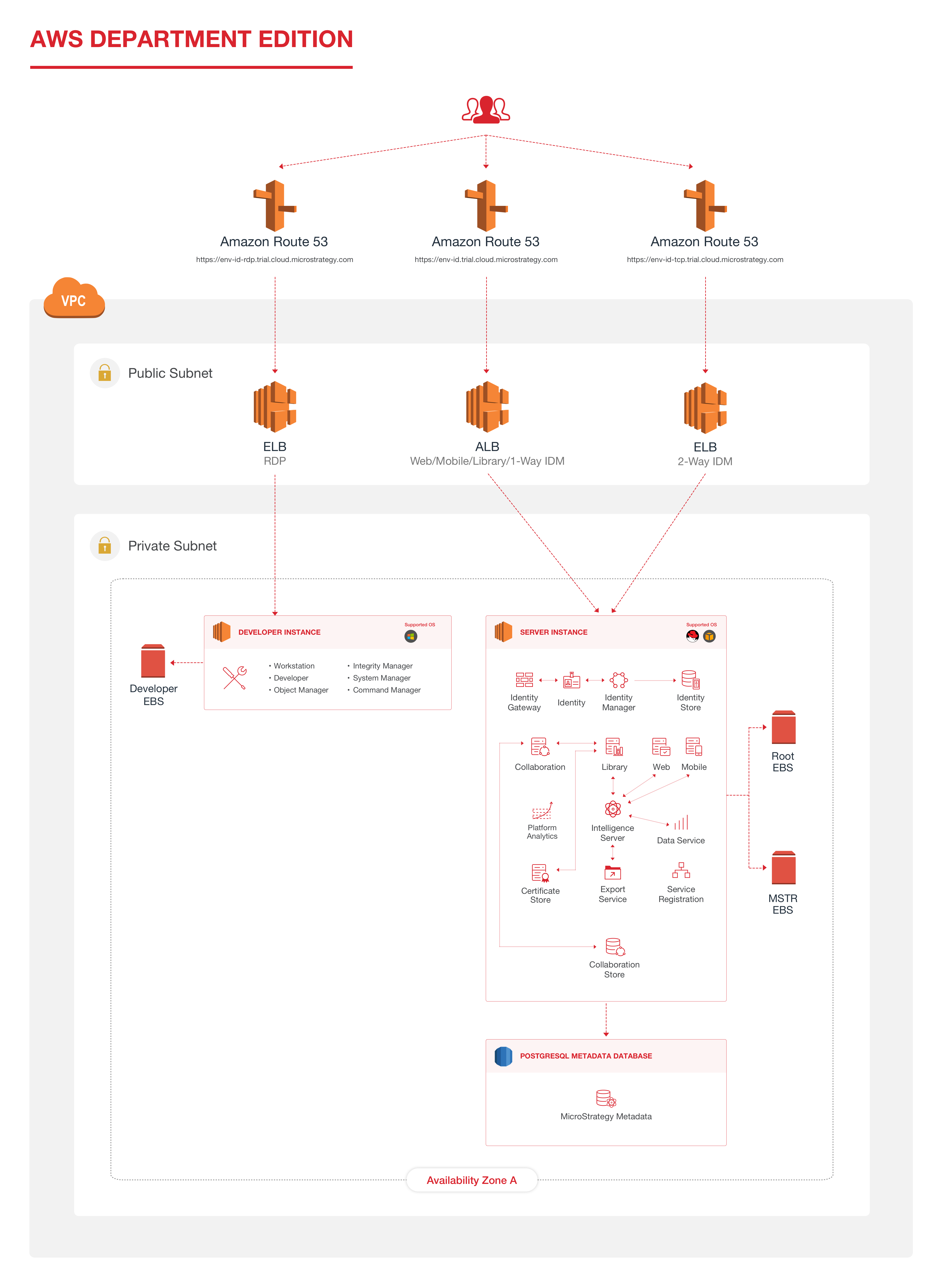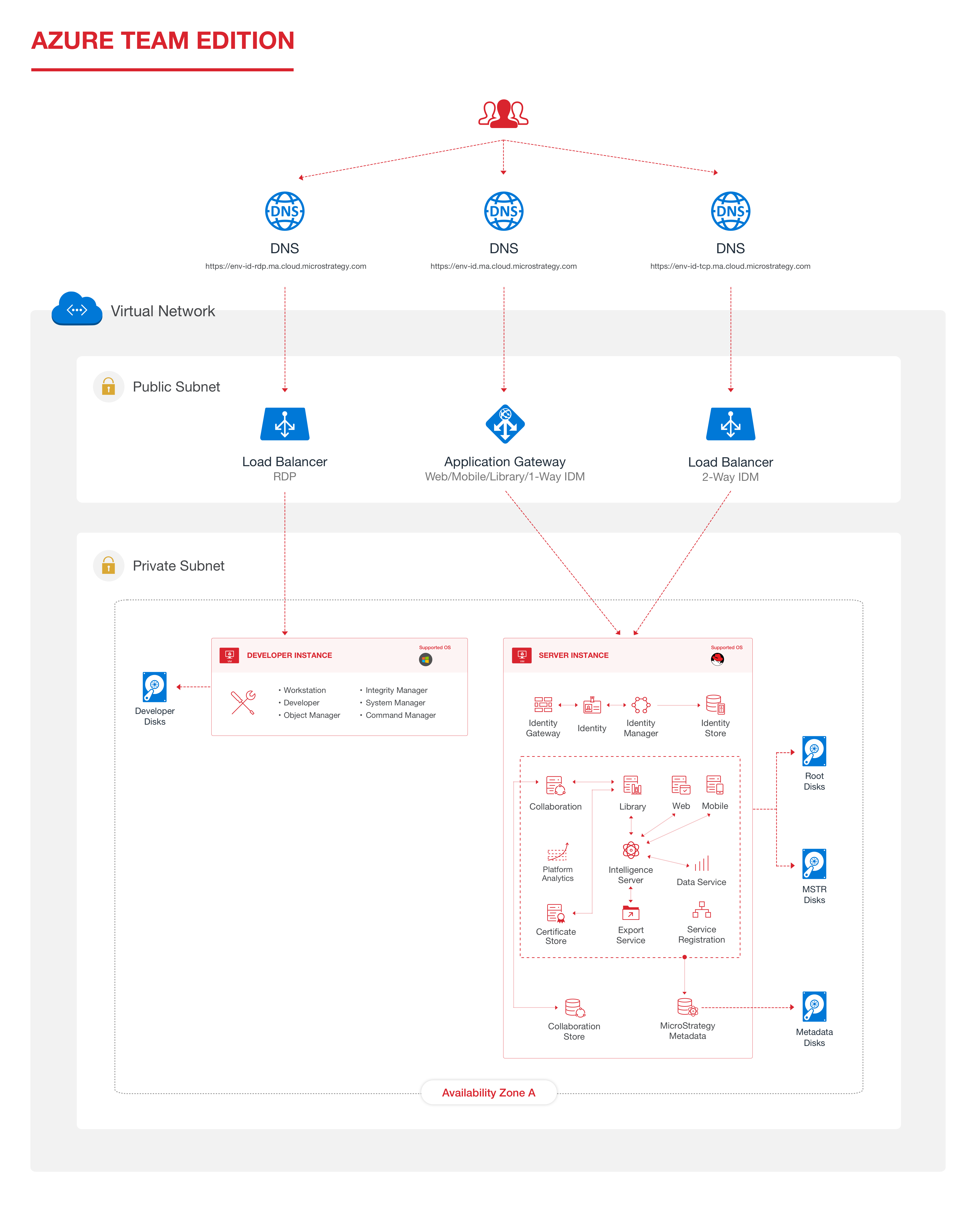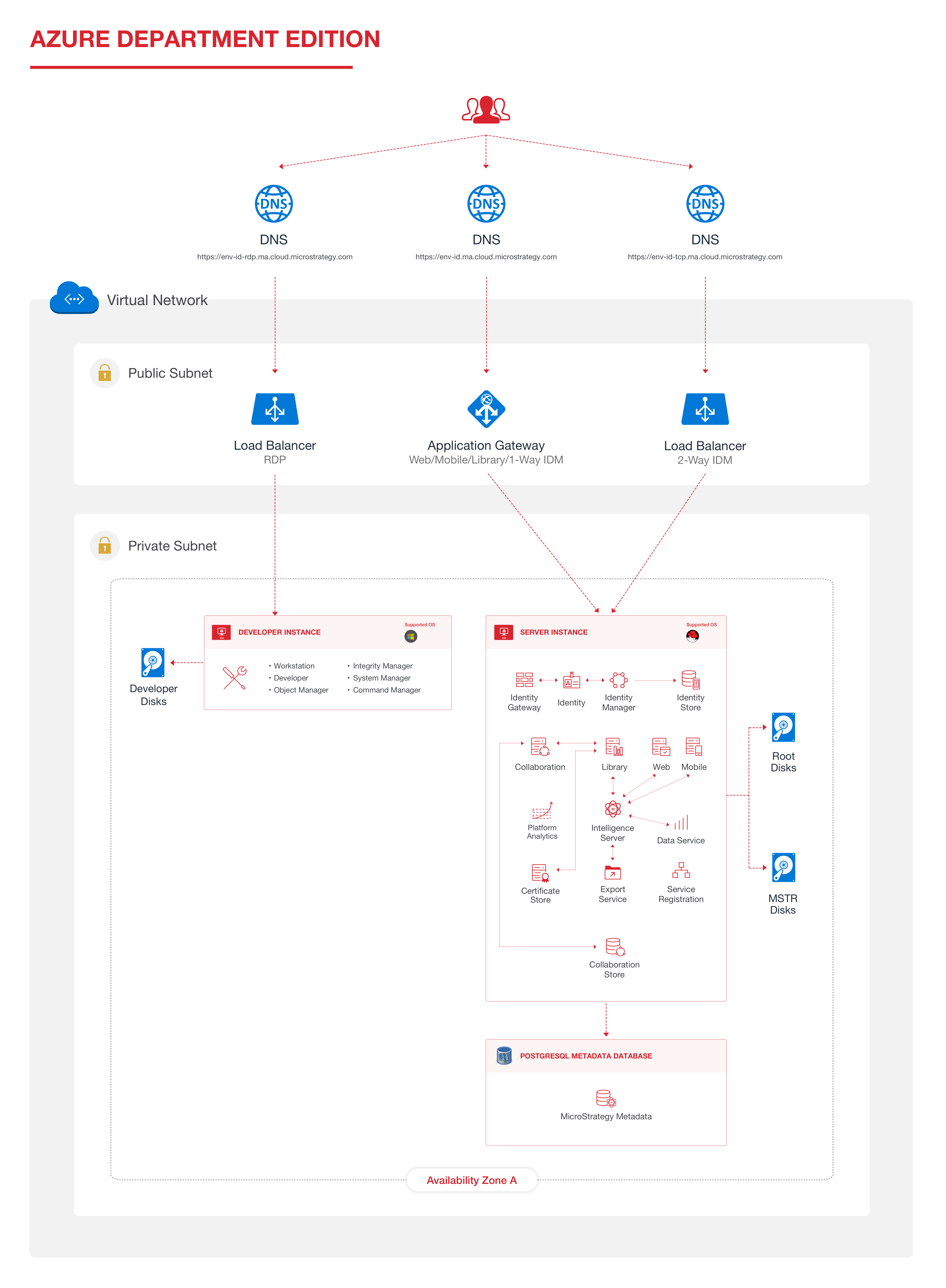Strategy ONE
Environment Types
- AWS
- Azure
When you create an environment, you have the option to select an environment type of Team, Department, or Enterprise. The three types have varying levels of features.
| Feature/Capability | Team | Department | Enterprise |
|---|---|---|---|
| Strategy Intelligence Server on RHEL 7 | X | X | X |
| Strategy Developer Instance on Windows Server 2016 | Optional | Optional | Optional |
| Strategy Web | X | X | X |
| Metadata hosted on AWS RDS (PostgreSQL database on RHEL 7) | X | X | |
| High Availability | X | ||
| Clustered Intelligence Server configuration | X | ||
| Multiple Availability Zones | X |
Team
The Strategy Cloud Platform for AWS Team Edition offers an all-in-one system designed for team application development and sharing. All the servers along with the metadata are on a single instance. You have the option to include a developer instance for data modeling and administration to increase productivity.
As Strategy Cloud's simplest architecture, a Team environment is an excellent starting point for users new to Strategy Cloud.
Technical highlights include:
- Strategy Intelligence Server running on RHEL 7
- MicroStrategy Developer running on Windows Server 2016 (optional)
- Strategy Web
- Web RDP and SSH access to the Linux and Windows machines
-
Metadata hosted on AWS RDS (PostgreSQL database on RHEL 7)
- The capability to deploy architecture with only private IPs (optional)

All resources reside in a single Availability Zone in the VPC created by the Infrastructure stack.
The Linux Intelligence Server and optional Windows Developer machines both reside within a Private Subnet within the Availability Zone, while the AWS Elastic Load Balancer (ELB) resides within a Public Subnet within the Availability Zone.
Both the Linux and Windows machines are attached to the ELB which allows easy access to Strategy Web for the Intelligence Server machine and easy RDP access for the Developer machine.
Around both the Linux and Windows machines you will see two AWS Security Groups. These Security Groups allow inbound traffic to each other, including RDP and SSH traffic.
The Team Edition is the basis for the other two Editions. Department and Enterprise Editions have the above architecture at their core.
Department
The Strategy Cloud Platform for AWS Department Edition is designed to cover the main requirements of small businesses or departments within large corporations.
It leverages the full power of the Strategy One Enterprise Platform while keeping the heart of the system (the Metadata repository) on its own dedicated resources.
The Department Edition provides:
- All the Enterprise Analytics capabilities available in the Team Edition
- Standalone metadata database to support higher performance and scalability
- Non-competing resources for the Intelligence Server and Metadata service for additional reliability
- The option to include a developer instance for data modeling and administration to increase productivity
- The capability to deploy architecture with only private IPs (optional)
One level of architectural complexity up from Team is the Department Edition. At its core, the Department Edition has the same underlying architecture as Team.
The diagram strongly resembles that of the Team Edition.
Notice that an AWS RDS instance has been added to the architecture. Like the Team Edition, there are still Elastic Load Balancers for the Linux and Windows machines, as well as Security Group communication between the two.
With the addition of the RDS instance, Security Group communication between the Linux, Windows, and RDS instance is enabled. All resources still reside within a single Availability Zone, including the RDS instance.

An important distinction between Team and Department is where the metadata is hosted. On Team environments, the metadata was hosted on the same RHEL 7 machine as the Intelligence Server. On Department environments, the metadata is hosted on AWS fully-managed database service, Relational Database Service (RDS).
Highlights of the Department Edition include:
- Strategy Intelligence Server running on RHEL 7
- MicroStrategy Developer running on Windows Server 2016 (optional)
- Strategy Web
- Web RDP and SSH access to the Linux and Windows Machines
-
Metadata hosted on AWS RDS (PostgreSQL database on RHEL 7)
Enterprise
The Strategy Cloud Platform for AWS Enterprise Edition is designed for customers looking for increased performance and scalability on their Strategy Enterprise Applications by leveraging elastic services and clustering and failover capabilities.
The Enterprise Edition provides:
- A distributed and redundant system for enterprise-grade and global applications
- A one-, two-, three-, or four-node deployment of Strategy Intelligence Server
- Standalone High Availability metadata database (PostgreSQL RDS)
- The option to include a developer instance for data modeling and administration to increase productivity
- The capability to deploy architecture with only private IPs (optional)
This environment builds off the basic infrastructure introduced in the Team Edition, incorporates the RDS introduced by the Department Edition, and adds High Availability functionality.
Highlights of the Enterprise Edition include:
- Two clustered Strategy Intelligence Server machines running on RHEL 7
- Machines hosted in separate AWS Availability Zones in your Region
- Machines with shared memory using AWS Elastic File Service (EFS)
- A more available, scalable single-node deployment option leveraging Highly-Available RDS and Amazon EFS
- MicroStrategy Developer running on Windows Server 2016 (optional)
- Strategy Web
- Web RDP and SSH access to the Linux and Windows Machines
-
Metadata hosted on AWS RDS (PostgreSQL database on RHEL 7)
- RDS hosted in multiple AWS Availability Zones in your Region
The diagram resembles that of the Department architecture, with the following important additions:
- Another Availability Zone
- Another Linux Intelligence Server machine
- Scalable file storage for cubes, caches, and plugins with Amazon EFS

This architecture still uses a single RDS instance, but it is highly available.
The second Linux Intelligence Server machine resides within the second Availability Zone and is clustered with the first Intelligence Server machine by means of AWS Elastic File Service.
Communication between the Intelligence Server, Developer Machine, and RDS instance remains the same as that of the Department deployment architecture.
When you create an environment, you have the option to select an environment type of Team, Department, or Enterprise. The three types have varying levels of features
| Feature/Capability | Team | Department | Enterprise |
|---|---|---|---|
| Strategy Intelligence Server on RHEL 7 | X | X | X |
| Strategy Developer Instance on Windows Server 2016 | Optional | Optional | Optional |
| Strategy Web | X | X | X |
| Metadata hosted on Azure Database for PostgreSQL | X | X | |
| High Availability | X | ||
| Clustered Intelligence Server configuration | X | ||
| Multiple Availability Zones | X |
Team
The Strategy Cloud Platform for Azure Team Edition offers an all-in-one system designed for team application development and sharing. All the servers along with the metadata are on a single instance. You have the option to include a developer instance for data modeling and administration to increase productivity.
As Strategy Cloud's simplest architecture, a Team environment is an excellent starting point for users new to Strategy Cloud.
Technical highlights include:
- Strategy Intelligence Server running on RHEL 7
- MicroStrategy Developer running on Windows Server 2016 (optional)
- Strategy Web
- Web RDP and SSH access to the Linux and Windows machines
-
Metadata hosted on the RHEL 7 machine in a PostgreSQL database
- The capability to deploy architecture with only private IPs (optional)

All resources reside in a single Availability Zone in the VNet created by the Azure Resource Manager.
The Linux Intelligence Server and optional Windows Developer machines both reside within a Private Subnet within the Availability Zone, while the Application Gateway resides within a Public Subnet within the Availability Zone.
Both the Linux and Windows machines are attached to the Load Balancer which allows easy access to Strategy Web for the Intelligence Server machine and easy RDP access for the Developer machine.
Around both the Linux and Windows machines you will see two Network Security Groups. These Security Groups allow inbound traffic to each other, including RDP and SSH traffic.
The Team Edition is the basis for the other two Editions. Department and Enterprise Editions have the above architecture at their core.
Department
The Strategy Cloud Platform for Azure Department Edition is designed to cover the main requirements of small businesses or departments within large corporations.
It leverages the full power of the Strategy One Enterprise Platform while keeping the heart of the system (the Metadata repository) on its own dedicated resources.
The Department Edition provides the following:
- All the Enterprise Analytics capabilities available in the Team Edition
- Standalone metadata database to support higher performance and scalability
- Non-competing resources for the Intelligence Server and Metadata service for additional reliability
- The option to include a developer instance for data modeling and administration to increase productivity
- The capability to deploy architecture with only private IPs (optional)
One level of architectural complexity up from Team is the Department Edition. At its core, the Department Edition has the same underlying architecture as Team.
The diagram strongly resembles that of the Team Edition.
Notice that an Azure Database for PostgreSQL instance has been added to the architecture. Like the Team Edition, there are still Application Gateway and Load Balancer for the Linux and Windows machines, as well as Network Security Group communication between the two.
With the addition of the Azure Database for PostgreSQL instance, Network Security Group communication between the Linux, Windows, and RDS instance is enabled. All resources still reside within a single Availability Zone, including the Azure Database for PostgreSQL instance.

An important distinction between Team and Department is where the metadata is hosted. On Team environments, the metadata was hosted on the same RHEL 7 machine as the Intelligence Server. On Department environments, the metadata is hosted on Azure fully-managed database service, Azure Database for PostgreSQL.
Highlights of the Department Edition include:
- Strategy Intelligence Server running on RHEL 7
- MicroStrategy Developer running on Windows Server 2016 (optional)
- Strategy Web
- Web RDP and SSH access to the Linux and Windows Machines
-
Metadata hosted on Azure Database (PostgreSQL database)
Enterprise
The Strategy Cloud Platform for Azure Enterprise Edition is designed for customers looking for increased performance and scalability on their Strategy Enterprise Applications by leveraging elastic services and clustering and failover capabilities.
The Enterprise Edition provides:
- A distributed and redundant system for enterprise-grade and global applications
- A one-, two-, three-, or four-node deployment of Strategy Intelligence Server
- Standalone High Availability metadata database (Azure Database for PostgreSQL)
- The option to include a developer instance for data modeling and administration to increase productivity
- The capability to deploy architecture with only private IPs (optional)
This environment builds off the basic infrastructure introduced in the Team Edition, incorporates the Azure Database for PostgreSQL introduced by the Department Edition, and adds High Availability functionality.
Highlights of the Enterprise Edition include:
- Two clustered Strategy Intelligence Server machines running on RHEL 7
- Machines hosted in separate Azure Availability Zones in your Region
- Machines using the Azure NetApp Files service, an enterprise‑grade managed network storage solution
- A more available, scalable single-node deployment option leveraging Highly-Available MD and Azure NetApp Files
- MicroStrategy Developer running on Windows Server 2016 (optional)
- Strategy Web
- Web RDP and SSH access to the Linux and Windows Machines
-
Metadata hosted on AWS RDS (PostgreSQL database on RHEL 7)
The diagram resembles that of the Department architecture, with the following important additions:
- Another Availability Zone
- Another Linux Intelligence Server machine
- Scalable file storage for cubes, caches, and plugins with Azure NetApp Files

This architecture still uses a single Azure Database for PostgreSQL instance, but it is highly available.
The second Linux Intelligence Server machine resides within the second Availability Zone and is clustered with the first Intelligence Server machine by means of Azure NetApp Files Service.
Communication between the Intelligence Server, Developer Machine, and Azure Database for PostgreSQL instance remains the same as that of the Department deployment architecture.
